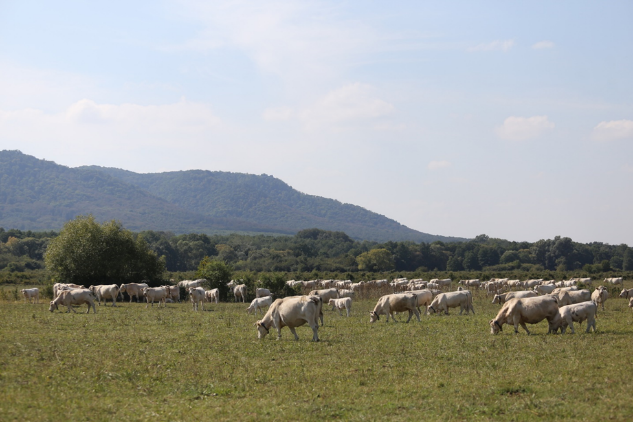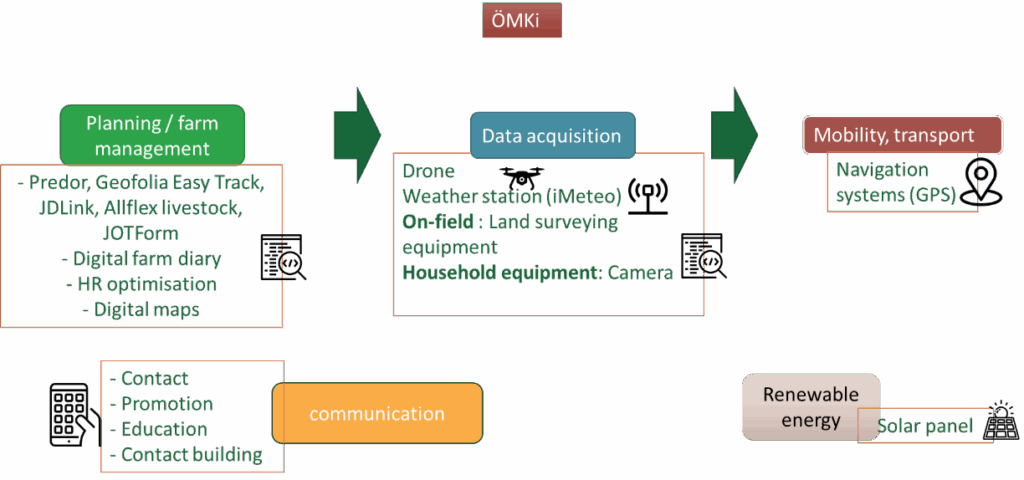Digital Tools Driving Sustainable Beef Cattle Farming in Hungary

Local context / Issue:
The Western Transdanubian region of Hungary is characterized by large surfaces for cattle production and very low human resource. The major challenge farmers are facing is how to control/monitor cattle for good health/well-being.
Showcase Outlook
The pride of a nation served in a dish. Goulash is probably the most recognised Hungarian contribution to the European culinary heritage. Even with its thicker version -the Marhapörkölt (beef stew)- few dishes like this represent the close relationship between the landscape and its people.
Behind its deep and flavourful paprika taste, Goulash evokes the endless plains that extend to the Carpathians. It reminds us of the legendary gallops of the Huns; the strong spirit of the Magyar tribes; the huge herds of cattle grazing on the grasslands; the ancient life of herdsmen and the role that livestock farming has played -and still plays- in the construction of the national identity of Hungary. That is why tending cows and calves today in Hungary is more than just another farming activity.
And, precisely, a means that guarantees the survival of this legacy is to innovate the livestock sector via digital tools. Sensors, LoRA data communication, the use of drones and IoT tools management can support tending cattle in a more efficient and sustainable way.
However, unreliable tools, limited functions for beef cattle management, the cumbersome bureaucracy of the administration, the digital divide among older farmers and the high cost of digital solutions are slowing down this progress. One of the main complaints of Hungarian farmers to adopting and implementing new tools is how to communicate their ideas and suggestions to the tech providers developers.
Despite these challenges, digital tools are promising for improving decision-making, grazing management, and livestock monitoring. Workshop participants expressed their interest in tools for tracking oestrus, predicting calving, and enhancing pasture utilisation. Several groups agreed that the major advantage of using digital tools is their ability to provide information, data, and analysis to support decision-making, as well as to help coordinate daily tasks better. But they would consider useful if these tools help them in the distribution and marketing of their products.
Digital solutions have not yet become widespread in the pasture-based beef cattle farming, and experiences in their use seem insufficient. Making the tools available and empowering farmers in moving forward towards innovative management will be crucial to keeping their activity.
And with them, the taste of Goulash will prevail for centuries. Sparking memories, feeding souls.
Showcase at a glance
Showcase representative name:
ÖMKi, Hungarian Research Institute of Organic Agriculture.
Challenge of the showcase: “Digitalisation to support extensive beef cattle farming with low human resource”.
Type of production:
Beef (meet) cattle farming.
Type of agroecology: Extensive production.
Participants: 11 attendees (3 women and 8 men), including 5 farmers but also advisors, association representatives and researchers.
Showcase representative: ???
Location: 5 farms all over Hungary
Website: https://www.biokutatas.hu/en

Testimonials
- Podcast with the showcase ambassador :
- Farmer’s interviews:
Mapping of digital tools used in ÖMKI’s showcase

A diversity of tools is used in the showcase, covering most of the range of existing digital technologies and supporting a diversity of operations on the farm. The picture illustrates the main tools for the main processes on the farm. More details about the tools are available in the Digital Tools section (link)
Usability/applicability of DTs: Main drivers, barriers, risks and trends

Drivers: #save & visualise data #time saving #working comfortIn Hungary, the main reasons why farmers use DTs in their farms are: (1) the opportunity to see all the data at the same time, transparency of data for tools linked with data saving; and (2) the efficiency improvement linked with the capacity to monitor, control & observe the farm including territory, animal and pasture. Indeed, due to labour shortage in the sector of grazing beef farming into very large pasture areas, DTs are a good opportunity for remote herd management, for instance to be quickly informed of the beginning of an illness, or a cow being close to calving….

Barriers: #dependency, vulnerability #ROI & cost #poor connectivityFarmers may not use DT because it makes them vulnerable to manufacturers or technicians (sharing data and paying subscription), they may not afford DTs due to price and maintenance costs, or their farm would not suit using DT due to low mobile network coverage leading to difficulty of access. Farmers who already bought tools can face GSM network problems which can cause difficulties in data collection. As a result, they may not use some tools in an optimised way.

Risks: #dependency #inaccuracyThe main risks towards digitalisation are considered to be the maintenance of DTs (vulnerability to the service network) and the reliability of DTs and the data itself (inaccuracy of data and decision making).

Looking to the future/trends: #automation & robotics #integrated data platform Participants agreed that they would like to use more integrated/common platforms or software to store, and share collected data (from drones, sensors…) and also virtual fencing, as can be used in Australia, for example, to replace electric fences. For this tool, connectivity is fundamental, but it can be very convenient when areas are large as in the showcase’s farms. For virtual fencing it is moreover necessary to check the regional regulations.
The added value of the used digital tools and technologies
When grouped according to specific management activities, digital tools and technologies become key enablers of the agroecological transition. Their combined use supports more resilient and sustainable farming practices. Explore how digital tools and technologies enhance this showcase management—step through the timeline of its core activities.
More details about the tools are available in the Digital Tools section (link).
Extensive beef cattle farming
What do farmers from this showcase expect as improvement or new function for digital tools to enhance their transition to more agroecological practices?
Gap analysis at farm scale
The participants primarily missed the following functions in the tools they use or are familiar with: alerting in situations when an animal is in danger, got lost or is calving, detecting heat stress individually, measuring suckling time of calves after birth. While several of these functions are mentioned in the manufacturer’s descriptions on currently available tools, they often do not work properly in practice or send frequent false alarms. These are due to the limited availability of technologies specifically designed for beef cattle, hence a wish for higher robustness of existing tools as well as new measurement tools. The significant administrative pressure is a basic problem for farmers. Therefore, they would find the interoperability of these systems useful in reducing this pressure. Examples include using RFID to facilitate animal identification and linking it with other digital tools, ensuring data interoperability, or integrating barcode or QR code scanners into sensor applications. These scanners could simplify the recording of medical treatments used for managing the animals into the software alongside the treatment records. These wish tools could be more integrated as well, suggest alerts, and be more user friendly. They can however find an opportunity through regulations which is that monitoring systems should appear. More generally, they blame the lack of financial support for improving investment capacities.
Gap analysis at supply chain scale
In Hungary, supply chains are quite short in beef cattle sector. Participants are selling living animals to local farmers or abroad, or producing their own beef products, and selling them directly to restaurants and consumers. The follow up and animal health documents still mainly based on papers, or kept by the veterinarian, e.g. Hungarian Unified Registration and Identification System. For using more digital tools in the supply chains the complete development of the whole Registration and Identification System is required. They think administration needs to develop digitally. Attendees mentioned digital technologies are mainly used to monitor animal development (sensors), weight gain (digital scales) and sales (PC, laptop, phone). Few digital devices are known to have functions that can help the supply chain. On breeding farms, the collection of DNA samples and microchipping of pedigree animals with high genetic value would be useful. Beef products leaving slaughterhouses have an advanced traceability system.
More details on the gaps found in the 6 showcases can be explored in the Gap Analysis section (link).

